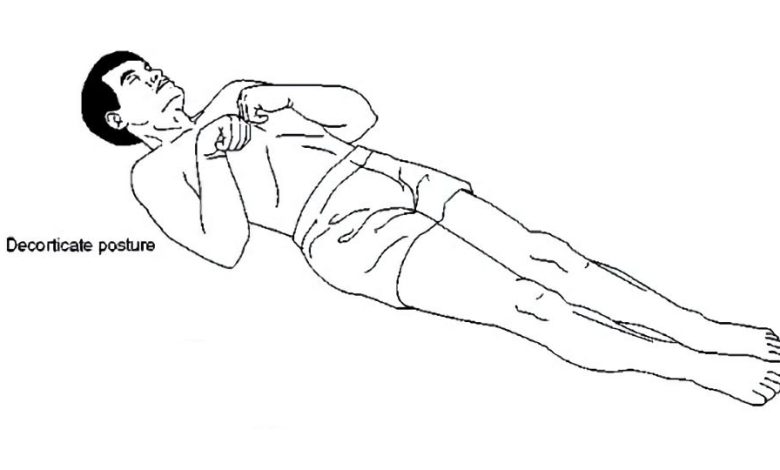Decorative rigidity: what is this, symptoms, diagnostics, treatment, prevention

Synonyms: Decorative rigidity; Pose “Mummy”
Abnormal posturing – decorticate posture; Traumatic brain injury – decorticate posture
What is decorative rigidity?
Decorative rigidity – the result of bilateral lesions of the deep hemispheres of the brain and functional shutdown of the corticospinal pathways. Manifested by persistent flexion of the upper extremities, bringing them to the torso and extending them, rotation of the lower extremities. This type of posture usually means, that there are serious and severe brain damage (this is a common cause of decorative rigidity).
It may alternate with another type of disorder, called decerebrate rigidity. A person may have decorative rigidity on one side of the body and decerebrate rigidity on the other side..
Causes of decorative rigidity
Causes of decorative posture include:
- Cerebral hemorrhage from any cause
- brain stem tumor
- Stroke
- Brain problems from-for drug, poisoning or infection
- Traumatic brain injury
- Brain problem due to liver failure
- Increased pressure in the brain for any reason
- Encephaloma
- Infection, such as meningitis
- Reye's syndrome (sudden brain damage and liver function problems, that hurt children)
- Brain injury from lack of oxygen
What to do with decorative rigidity
If a person has decorative rigidity, he must be immediately taken to a medical facility.
When to see a doctor for decorative rigidity
Decorative rigidity is the cause of an urgent visit to the doctor and an ambulance call.
What the doctor will do when diagnosing decorative rigidity
Patient needs immediate emergency care. It involves inserting a breathing tube into the lungs. The person will be immediately hospitalized and placed in an intensive care unit..
As soon as the patient's condition stabilizes, the doctor will ask family members or friends about medical history and perform a more complete physical exam. It will include a thorough study of the brain and nervous system.
Family members will be asked questions about the person's medical history, including:
- When the symptoms started?
- Has the patient had similar problems before??
- Whether there were head injuries or other brain diseases?
- What other symptoms appeared before the appearance of decorative rigidity?
Tests may include:
- Blood tests and urine, screening for drugs and toxic substances, as well as the presence of certain chemicals in the body
- Angiography of the brain (injection of a radiopaque dye and x-rays of blood vessels in the brain)
- CT or Head MRI
- EEG (brain wave testing)
- Monitoring of intracranial pressure (ICP)
- Poyasnichnaya puncture for collection of cerebrospinal fluid
The prospects for recovery depend on the cause of the decerebrate rigidity.. The victim may have severe damage to the brain and nervous system, which may lead to:
- To whom
- inability to communicate
- paralysis
- convulsions
Sources
- Ball JW, Dains JE, Flynn JA, Solomon BS, Stewart RW. Neurologic system. In: Ball JW, Dains JE, Flynn JA, Solomon BS, Stewart RW, eds. Seidel’s Guide to Physical Examination. 9th ed. Philadelphia, PA: Elsevier; 2019:chap 23.
- Hamati AI, Felkar MV. Neurological complications of systemic disease: children. In: Jankovic J, Mazziotta JC, Pomeroy SL, Newman NJ, eds. Bradley and Daroff’s Neurology in Clinical Practice. 8th ed. Philadelphia, PA: Elsevier; 2022:chap 59.
- Papa L, Goldberg SA. Head trauma. In: Walls RM, Hockberger RS, Gausche-Hill M, eds. Rosen’s Emergency Medicine: Concepts and Clinical Practice. 9th ed. Philadelphia, PA: Elsevier; 2018:chap 34.
